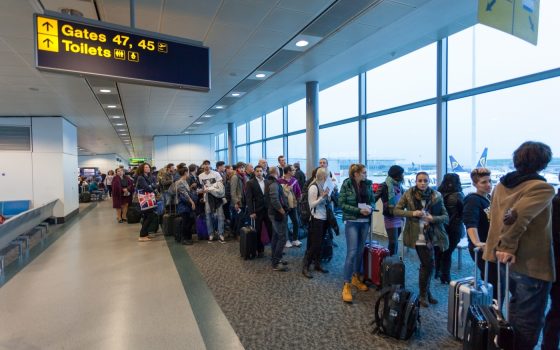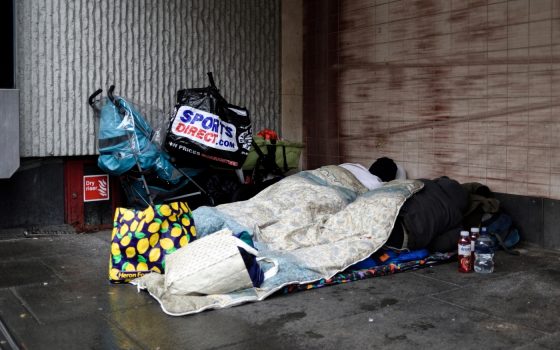A third of the UK population will be living in hardship by May
New analysis shows that over 1 million more people will be living on an income with which they can’t afford to meet every day needs by May compared to last September, even if the £20 uplift extended at next week’s budget
01 March 2021
By May, one in three people (21.7 million) will have too little income to afford the basics for a decent standard of living (the Minimum Income Standard), according to new analysis from the New Economics Foundation (NEF). Within this, 12.9 million people (one in five) will be living at an especially high risk of material deprivation (below 75% of the Minimum Income Standard), if the uplift is removed.
The Minimum Income Standard (MIS) is calculated by the Joseph Rowntree Foundation and Centre for Research in Social Policy to give a threshold for the “minimum socially acceptable standard of living” and provides the basis for calculating the real living wage. Unlike poverty thresholds, which is a relative measure of income, this is calculated on the basis of the level of income needed to afford the basics.
The analysis, which updates NEF’s forecast of people living below the MIS, shows that even if the £20 per week uplift to universal credit is extended by six months, there will be an additional 1.1 million people living below the MIS compared to September 2020 and an additional 1.2 million living below 75% of MIS and at high risk of material deprivation. By November 2021, when the universal credit uplift is likely to come to an end, there will be an additional 1.2 million people living below the MIS compared to September 2020 and 1.8 million people living in households below 75% of the MIS.
The analysis shows that despite expected economic recovery overall and falling unemployment levels, removing the £20 uplift after six months will increase the number of people living at high risk of material deprivation. Between May 2021 and November 2021, the number of people living in households below 75% of the MIS will increase by 600,000 if the uplift is only extended for 6 months.
The analysis uses the latest labour market and economic data, as well as the latest Bank of England forecasts for Q2 (April to June) 2021 and Q4 (October to December) 2021 to forecast the number of people set to fall below the MIS in the spring and autumn of this year. The forecast also shows the number of households living on less than 75% of the MIS, who are four times more likely to experience material deprivation than those above.
The analysis also reveals the extent to which hardship will be faced right across the UK by November, assuming the £20 uplift is removed.
- In the North East, around 1 million people will be living in households with income below a minimum acceptable standard of living (below the MIS) and 600,000 of them will be at high risk of material deprivation (below 75% of the MIS)
- In the North West, 2.5 million will be will be living in households with income below a minimum acceptable standard of living and 1.5 million of them will be at high risk of material deprivation
- In Yorkshire and the Humber, 1.9 million will be below the MIS and 1.1 million of them will be at high risk of material deprivation
- In the East Midlands, 1.4 million will be below the MIS and 800,000 of them will be at high risk of material deprivation
- In the West Midlands, 2 million will be below the MIS and 1.2 million of them will be at high risk of material deprivation
- In the East of England, 1.8 million will be below the MIS and 1.1 million of them will be at high risk of material deprivation
- In London, 3.4 million will be below the MIS and 2.3 million of them will be at high risk of material deprivation
- In the South East, 2.5 million will be below the MIS and 1.4 million of them will be at high risk of material deprivation
- In the South West, 1.7 million will be below the MIS and 900,000 of them will be at high risk of material deprivation
- In Wales, 1.0 million will be below the MIS and 500,000 of them will be at high risk of material deprivation
- In Scotland, 1.5 million will be below the MIS and 800,000 of them will be at high risk of material deprivation
- In Northern Ireland, 600,000 will be below the MIS and 300,000 of them will be at high risk of material deprivation
Latest labour market data released this month shows that last quarter the unemployment rate was 5.1%, 1.3% higher than last year. And with furlough due to end in April, the Bank of England projects unemployment will rise to 7.8% in April-June 2021. As a result, millions of people are relying on our social security system to support incomes and help put food on the table. The latest data reveals there were 5.9 million on universal credit by December 2020.
NEF argues that, as a bare minimum, the £20 uplift must be maintained for those on Universal Credit or receiving Working Tax Credit, and as well extended to those on legacy benefits who do not currently have access to it. But, pointing to the severity of the number of those struggling even with the uplift, argues that these measures are not adequate compared to the scale of the income crisis the UK is facing. NEF is therefore calling for a living income, starting with a new minimum income guarantee, that ensures no one would fall below a level needed to live a decent life. The guarantee would ensure that everyone who needs it receives at least £227 a week through the rest of the pandemic – making the UK economy stronger and pushing money back into local communities.
Sarah Arnold, Senior Economist at the New Economics Foundation, said:
“There seems to be light at the end of the tunnel in this pandemic but we are by no means out of the woods yet. If the public health crisis abates as we all hope it will, it will lay bare the true extent of the crisis in living standards that is now a reality for millions of families.
“NEF’s new analysis shows the devastating impact the crisis is having on people across the country and even if the economy starts to recover this year, we will still see an increase in the number of households falling into extreme hardship. This isn’t right – we shouldn’t be leaving anyone out of the recovery.
“The £20 uplift and the furlough scheme were a recognition by the government that our current safety net is insufficient to protect livelihoods and incomes. It is time to build one that does, and that is fit for the future. Part of this should be a Living Income to ensure that people have enough to live, not just survive.”
Contact
Sofie Jenkinson, sofie.jenkinson@neweconomics.org, 07981023031
Notes to editors
The full analysis is available at https://neweconomics.org/2021/02/millions-facing-an-income-crisis
The New Economics Foundation is a charitable think tank. We are wholly independent of political parties and committed to being transparent about how we are funded.
The latest data reveals there were 5.9 million on Universal Credit by December 2020. And there were 3 million people receiving housing benefit, 2.5 million receiving Personal Independence Payment, 1.9 million receiving Employment Support Allowance, 1.4 million receiving Disability Living Allowance, and 0.3 million receiving Jobseeker’s allowance (latest data for these benefits is from August 2020).
The number of people living in families with incomes below the MIS is set to rise significantly compared to the last year.
Removing the £20 uplift halfway through the year would increase the number of families living with insufficient incomes, despite unemployment falling, across all regions






